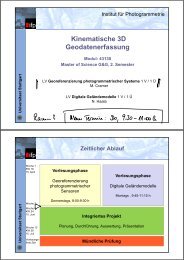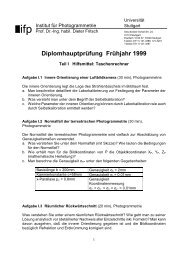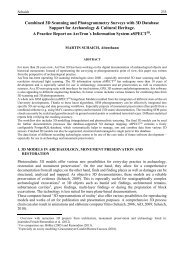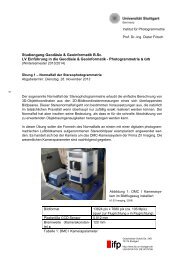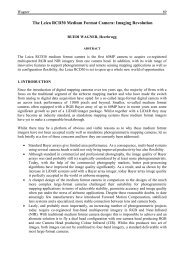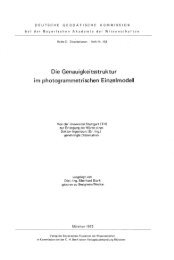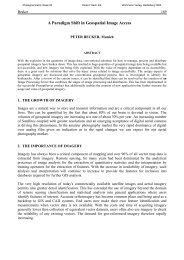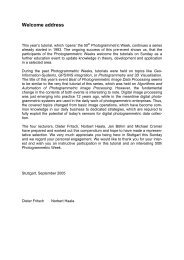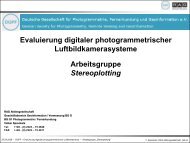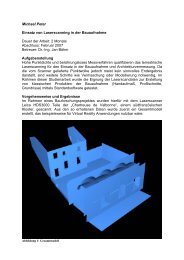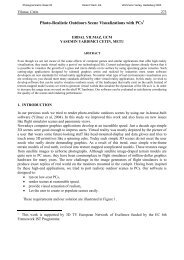The Photogrammetric Week Series – A Centennial Success Story
The Photogrammetric Week Series – A Centennial Success Story
The Photogrammetric Week Series – A Centennial Success Story
Create successful ePaper yourself
Turn your PDF publications into a flip-book with our unique Google optimized e-Paper software.
'<strong>Photogrammetric</strong> <strong>Week</strong> 05' Dieter Fritsch, Ed. Wichmann Verlag, Heidelberg 2005.<br />
Fritsch 3<br />
<strong>The</strong> <strong>Photogrammetric</strong> <strong>Week</strong> <strong>Series</strong> <strong>–</strong> A <strong>Centennial</strong> <strong>Success</strong> <strong>Story</strong><br />
DIETER FRITSCH, Stuttgart<br />
ABSTRACT<br />
When Dr. Carl Pulfrich 1909 introduced the “Vacation Course in Stereophotogrammetry”, terrestrial photogrammetry<br />
has driven most applications. He, the founder of stereo-photogrammetry, was convinced, that after the introduction of<br />
the stereo comparator (1901) a new milestone was needed to improve the accuracy of photogrammetric object<br />
reconstruction. Obviously, there is nothing better than initiating an open discourse between scientists, developers and<br />
practitioners. This great idea has driven all <strong>Photogrammetric</strong> <strong>Week</strong>s and been maintained until today. We, the past and<br />
present organizers, speakers and participants gratefully acknowledge the idea of technology transfer in this manner.<br />
<strong>The</strong> paper first remembers to Dr. Carl Pulfrich, the physicist and photogrammetrist, and refers to his contributions to<br />
stereo photogrammetry. Speaking about 100 years of <strong>Photogrammetric</strong> <strong>Week</strong>s should also remember the big milestones<br />
in photogrammetric history, complemented by general historical remarks. Nowadays, the <strong>Photogrammetric</strong> <strong>Week</strong> <strong>Series</strong><br />
are well documented by a digital archive which is improved step by step in the future. Some photographs complement<br />
the historical journey in time just to show the spirit of the events. <strong>The</strong> structure of having invited speakers in the<br />
mornings and vendor demonstrations in the afternoons is optimized - the social program provides ample time for<br />
intercultural relations and simply to maintain friendships. <strong>The</strong> paper concludes with an outlook to the next years of<br />
photogrammetric research and development.<br />
1. REMEMBERING DR. CARL PULFRICH<br />
Carl Pulfrich was born on September 24, 1858 as first son of a school teacher in Burscheid near<br />
Dusseldorf. After primary and secondary school he studied Physics, Mathematics and Mineralogy at<br />
Bonn University. At that time, the German Empire or “German Reich” - just launched in 1871 -<br />
provided stable political basic conditions to the well-being of science, economics and culture.<br />
Prince Otto von Bismarck, the first “Reichs”chancellor, delivered and implemented the pillars of<br />
the German social security system which are still in progress until today, but <strong>–</strong> most probably <strong>–</strong><br />
have to be adjusted to the “missing children society” of 2005.<br />
Fig. 1: Dr. Carl Pulfrich<br />
Right after graduation Carl Pulfrich started research in optics<br />
and finished a PhD thesis in 1881. He accepted a position as<br />
assistant and lecturer at the Institute of Physics at his Alma<br />
mater (1885-1890) and started a collaboration with chemists to<br />
design and build a new refractometer. This kind of instruments<br />
delivers measurements for the determination of the refraction<br />
index of optical media using the refraction or total reflection of<br />
light. During this work he excited the attention of Dr. Ernst<br />
Abbe, who, as Partner of Carl Zeiss, built a refractometer as<br />
well. In 1890, Dr. Abbe invited Dr. Pulfrich to become an<br />
associate of the Carl Zeiss Jena enterprise, mainly to design<br />
optical measurement instruments. He accepted and stayed<br />
there until he died 1927.<br />
By the way, Carl Zeiss, an university mechanic, founded his<br />
company 1846. He started to build microscopes for biological,<br />
chemical and medical applications. He realized<br />
very soon, that further improvements of his microscope<br />
products could only be made by scientific computations. Thus,
4 Fritsch<br />
he started in 1866 the collaboration with Dr. Ernst Abbe, at that time a professor of physics at Jena<br />
University. In 1875 Dr. Abbe became partner and shareholder of the Carl Zeiss enterprise and<br />
started the development of optical-mechanical instruments. Carl Zeiss passed away in 1888, leaving<br />
327 associates in his company.<br />
Photogrammetry at those times was not yet developed at all. A first hint on using photogrammetric<br />
techniques was already given by the French physicist Francoise Arago (1786-1853), when he 1839<br />
explained the invention of photography in front of scientists at the French Academy in Paris. He<br />
pointed out, that his new invention could serve “ to measure the highest und unaccessible buildings<br />
and to replace the fieldwork of a topographer”. Most probably, Arago knew about the work of J.H.<br />
Lambert, a great German mathematician (1728 <strong>–</strong> 1777), who published in 1760 investigations to<br />
reconstruct spatial objects using perspective drawings.<br />
As soon as photography had reached some level of quality (around 1850), efforts began to use<br />
photographs for the measurement of photographed objects, through what the discipline of<br />
photogrammetry actually has been invented. Obviously, the efforts were indeed focused to the<br />
surveying of terrain in order to derive topographic maps, and on the other hand, to reproduce exact<br />
ground plans and drawings of buildings. <strong>The</strong> photogrammetric techniques concentrated for about 50<br />
years (1850 <strong>–</strong> 1900) on photographs of objects, which were taken from several locations showing<br />
different views. <strong>The</strong> task at that time was to find homologue points, corners and edges in the<br />
photographs and to reconstruct a ground plan simply by intersections. Very soon it became clear,<br />
that the search for corresponding (matching) image features could only be successful in<br />
architectural photographs and photographs of salient or mountainous terrain, that means, images<br />
having sharp object features.. Unfortunately, it failed in images representing smooth object features.<br />
At those days, Italians and Austrains described photogrammetry as successful method to deliver<br />
topographic maps of mountainous terrain. <strong>The</strong> German architect, A. Meydenbauer made in 1858 the<br />
first photogrammetric reconstruction of a building. It is said, that he carried out his experiments<br />
without knowing about the similar approaches and proposals reported some years before. He was<br />
very successful in the way, that the Prussian Secretary of Cultural Affairs provided him resources to<br />
found the “State Photograph Institute Maintaining Architectural Monuments (Staatliche<br />
Messbildanstalt für Baudenkmäler)”.<br />
Most probably, Abbe and Pulfrich discussed also the methods of photogrammetry, when Pulfrich<br />
entered Carl Zeiss. In 1896 Pulfrich had the job to advance the stereoscopic distance meter, which<br />
was invented by H. de Gousilliers and continued by Abbe. Simultaneously with this development<br />
Pulfrich followed the idea, to decompose the measurement principle of the stereoscopic distance<br />
meter into two temporally independent views, which were photographed through spatially separated<br />
lenses and could be measured afterwards stereoscopically. Herewith, Pulfrich became father of<br />
stereo photogrammetry!<br />
In restless activity Pulfrich developed the theory and instruments of stereo photogrammetry. In<br />
1901 he presented the stereo comparator, which was followed by the stereo autograph plotter of E.<br />
von Orel in 1908 (and not 1911 as reported by many books). <strong>The</strong> ideas of Pulfrich and the expertise<br />
of the “Zeissians” helped to make this big instrumental progress with a mechanical spacerod<br />
restitution. With this instrument the first-ever automatic mapping was made possible, using two<br />
photographs of arbitrary terrain, a real breakthrough. One can definitely say, that starting with 1900<br />
the company Carl Zeiss has pioneered and actively promoted photogrammetry for about one<br />
century. Having strong expertise in optics combined with the craft of instrument making the<br />
company was predestined to meet the challenges. Thus, it seems sheer coindicidence, that about<br />
the same time when Pulfrich invented the stereo comparator, the South African H. G. Fourcade<br />
presented his Measuring Stereoscope and Survey Camera (in 1904). He compiled the first-ever<br />
terrestrial topographic map covering the slopes of Devils Peak (near Cape Town). As to who was<br />
the first, or whether the credit is due to Germany or South Africa will remain an unsolved question<br />
(H. Krahmann, 2001).
Fritsch 5<br />
<strong>The</strong> abundance of Pulfrich’s work and contributions to the field of stereo photogrammetry is even<br />
more astonishing, as he got blind with one eye in 1906 and therefore was not more capable to see<br />
stereoscopically. But his lively spirit overcame the lack of exact spatial perception. He died on<br />
August 12, 1927 when his rowing boat turned down in the Baltic Sea.<br />
2. SOME MILESTONES IN PHOTOGRAMMETRY AND THE PHOTOGRAMMETRIC<br />
WEEKS<br />
2.1. If one considers the invention of the stereo comparator in 1901 by Dr. Carl Pulfrich (see fig.<br />
2), the chief measurement instrument designer of Carl Zeiss Jena, as the starting point of stereo<br />
photogrammetry, we probably can better understand his intention to start a “vacation course in<br />
stereo photogrammetry”. <strong>The</strong> real achievement was to add the third dimension by measuring the<br />
parallax in baseline direction in a pair of stereo photographs, but obviously not many took notice of<br />
this revolutionary breakthrough. <strong>The</strong>refore, there was a real need for technology transfer, what<br />
means, simply to make the technology known at all. In June 1909 Pulfrich sent out a call in the<br />
German ‘Zeitschrift fuer Vermessungswesen (ZfV)’ for such a vacation course, which then took<br />
place in Jena from October 4 th to 9 th . It is known that 46 participants came together - apart from<br />
Germany they came from Austria (4), former Yugoslavia (2) and one representative each from<br />
Russia, former Czechoslovakia and Hungary. <strong>The</strong> course contained lectures and instruments<br />
training with instruments made available by Carl Zeiss Jena. From a management point of view the<br />
course was run and managed on a more or less private basis by Pulfrich himself. <strong>The</strong> fee was 20<br />
Marks.<br />
<strong>The</strong> first-ever course is also a milestone in the history of the German Society for Photogrammetry,<br />
Remote Sensing and Geoinformation (DGPF), because in a restaurant outside of Jena, these<br />
gentlemen were sitting together and founded the society. It is needless to say, that most probably,<br />
they have had a good dinner and some beers, as it was and still is the standard of the social program<br />
of all <strong>Photogrammetric</strong> <strong>Week</strong>s.<br />
Fig. 2: Stereo comparator of Dr. Carl Pulfrich (Zeiss Jena, 1901) <strong>–</strong> most probably the training instrument of the firstever<br />
vacation course<br />
<strong>The</strong> vacation courses were maintained in the following years, that means, they took place also in<br />
1910 until 1913, having more or less the same structure and same number of participants. <strong>The</strong>ir<br />
location was the ‘Volkshaus’ of the Carl Zeiss Foundation, a building with several halls, in which<br />
one hall was rented for the lectures and another one for the instrument measurements. Terrestrial<br />
photographs were taken by the participants in the near vicinity of Jena, who had to measure them as<br />
well. <strong>The</strong>se first series of five courses were interrupted by the first World War (1914 <strong>–</strong> 1918).
6 Fritsch<br />
2.2. Carl Zeiss Jena, as a leading supplier of optical instruments had by then already been in<br />
existence for some sixty years. Terrestrial photogrammetry was the absolutely application, but most<br />
probably, as later, a small segment within the portfolio of the Zeiss company. <strong>The</strong> first range of<br />
Photo <strong>The</strong>odolites was followed in 1915 by the first camera for exposing a a controlled series of<br />
aerial photographs. Camera design and optical perfection have ever since been an ongoing<br />
challenge. By 1937 Carl Zeiss Jena had already manufactured about 5,000 cameras. By 1921 the<br />
potential of photogrammetry reached a volume that made it necessary to establish Zeiss<br />
Aerotopograph, a subsidiary to take charge of worldwide marketing. On the processing side, the<br />
Universal Stereoplanigraph with optical restitution followed in the same year. This was a truly ‘first<br />
order’ plotter with base-in/base-out facility to accomplish strip triangulation. <strong>The</strong>n there was the<br />
Multiplex Projector System where a battery of up to 21 Anaglyph Projectors served 1:25,000<br />
topographic mapping and triangulation. For photo-mapping the self-focusing SEG rectifier was<br />
offered in 1921 as well, and the slotted template method as a mechanical form of triangulation<br />
served the composition and mosaiking of large blocks of photographs.<br />
Around 1920 Pulfrich himself turned towards photometry, leaving the development of<br />
photogrammetric instruments to a new generation of scientists and developers, such as W. Sander,<br />
Walther Bauersfeld and Otto von Gruber (see fig. 3). Von Gruber, a professor of Universitaet<br />
Stuttgart, became head of department of Carl Zeiss Jena in 1930. Before he left the university, he<br />
organized the “ 6 th Vacation Course in Photogrammetry” from April 8 th to 20 th , 1929. Again 41 par-<br />
ticipants came from 14 countries, in the meantime two from<br />
overseas, from China and Dutch India. <strong>The</strong> settings of the course<br />
did only slightly change, but the main emphasis was now aerial<br />
photogrammetry. Also here, the course was managed by von<br />
Gruber himself, the fee was 100 Marks, which had to be paid into a<br />
personal account. Von Gruber was a very dominating scientist,<br />
probably the discussions were driven by him and the atmosphere<br />
was by far not that relaxed as it was with the inventor of the course.<br />
All lectures were well documented in a book edited by von Gruber<br />
and published by the publishing house Konrad Wittwer, Stuttgart.<br />
<strong>The</strong> book itself is well-written and contains many actual formulas<br />
and content still valid until today.<br />
From 1929 until 1940 some more 15 vacation courses were held in<br />
Jena in a quick succession. It should be mentioned here, that<br />
from 1932 the Zeiss Aerotopograph company organized the<br />
Fig. 3: Prof. Otto von Gruber<br />
meeting. <strong>The</strong> name changed for the first time in 1933 when the<br />
course was called “Introductory Courses” or alternatively “Jena<br />
Introductory Courses in Photogrammetry”. Obviously, the term “<strong>Photogrammetric</strong> <strong>Week</strong>s”<br />
appeared 1937 for the first time, the courses lasted as a rule for two weeks. In 1932 Prof. Reinhard<br />
Hugershoff from Technical University Dresden (TUD), professor of surveying and<br />
photogrammetry, joined the organization team around Prof. von Gruber and shared the<br />
organization until 1940.<br />
2.3. <strong>The</strong> postwar era meant a restart virtually from scratch, not only for the <strong>Photogrammetric</strong> <strong>Week</strong><br />
series, but for photogrammetry itself. With the division of Germany Carl Zeiss Jena was split into<br />
an eastern (Jena) and western camp (Oberkochen) and with the fading hopes for an early<br />
reunification, new developments began in both quarters. By now strong competition was on the<br />
move with Wild Heerbrugg dominating the photogrammetric plotter market. <strong>The</strong> Oberkochen<br />
division made significant achievements particularly on the camera side. <strong>The</strong> distortion-free RMK A<br />
series was introduced 1967 followed in the early nineties by the current RMK Top which will still
Fritsch 7<br />
stands for many years to come. In the east the LMK was presented 1982 followed by the first<br />
stabilized camera mount and FMC performance as trend-setting innovations.<br />
<strong>The</strong> Zeiss GZ 1 Orthoprojector presented at the ISPRS Lisbon congress found an overwhelming<br />
reception and opened up a new market for orthophoto products, which have ever since on offer with<br />
a wide choice of superimposed cartographic details. Incidentally, the first experimental Orthophoto<br />
produced in South Africa again covered the slopes of the Devils Peak mountain with the rig Survey<br />
Deaprtment and the University of Cape Town. It was run by Dr. Walter Brucklacher from Carl<br />
Zeiss Oberkochen, an enthusiastic promoter of orthophoto technology.<br />
Fig. 4: <strong>The</strong> 22 nd <strong>Photogrammetric</strong> <strong>Week</strong> at the Technical<br />
University of Munich (1954), a) from left: Prof Richard<br />
Finsterwalder (TUM), Prof. Kurt Schwidefsky (Carl Zeiss<br />
Oberkochen), and Dr. E.O. Messter, Zeiss Aerotopograph<br />
Munich<br />
b) Excursion to the Wallberg and demonstration of the<br />
TAF (Terrestrial facility Finsterwalder); at the<br />
instrument; Eng. H. Baumert, right hand Dipl.-Ing.<br />
Hans-Karsten Meier, TU Munich.<br />
<strong>The</strong> <strong>Photogrammetric</strong> <strong>Week</strong> organizers Hugershoff and von Gruber passed away 1941 and 1942,<br />
respectively. Prof. Kurt Schwidefsky, associate of the Carl Zeiss Oberkochen, and who had taken<br />
part in the pre-war events a s a lecturer, took the lead to the next milestones. <strong>The</strong> company Zeiss<br />
Aerotopograph, organizer of the <strong>Photogrammetric</strong> <strong>Week</strong> series since 1932, moved from Jena to<br />
Munich. Its director, E.O. Messter, was also an enthusiast of photogrammetry, its instruments and<br />
applications. <strong>The</strong> tradition continued in 1951 with the name “<strong>Photogrammetric</strong> <strong>Week</strong>” in Munich,<br />
the 21 meeting of this series. At that time, a new aspect came into effect in the way, that a<br />
collaboration with an university was searched for. Prof. Schwidefsky found in Prof. Richard<br />
Finsterwalder an excellent partner (see fig. 4a), and hence the events took place at the Technical<br />
Fig. 5: Snap shots at the <strong>Photogrammetric</strong> <strong>Week</strong>s Munich, a) 1955 at the Demos, and b) 1958 Prof. Schwidefsky as<br />
session chairman.
8 Fritsch<br />
University of Munich (TUM). <strong>The</strong> postwar beginning was hard to realize. In 1951 only 28<br />
participants were present, from no less than 13 countries, amongst them the USA. Between 1951<br />
and 1963 the event was jointly organized by the Zeiss Aerotopograph company in association with<br />
TUM and held nine times with increasing participation from countries from all over the world.<br />
2.4. <strong>The</strong> sudden death of Prof. Finsterwalder in 1963 brought up another milestone in the history of<br />
the <strong>Photogrammetric</strong> <strong>Week</strong> series. In the meantime Prof. Schwidefsky had left the Carl Zeiss<br />
Oberkochen company to take over a chair of the Technical University Karlsruhe. Additionally, the<br />
Zeiss Aerotopograph company was taken over by Carl Zeiss Oberkochen, when Messter left the<br />
former company. Fortunately, Prof. Schwidefsky still felt responsibility for the courses and shifted<br />
them to Karlsruhe, where it was held four times (1965 until 1971). He shared first the organization<br />
with Dr. Ahrend from Carl Zeiss Oberkochen, later with Dr. H. K. Meier (Carl Zeiss Oberkochen)<br />
and Prof Fritz Ackermann, Universitaet Stuttgart. <strong>The</strong> number of participants increased up to 160 in<br />
average.<br />
<strong>The</strong>se were the times when the Analytical Plotters were introduced. <strong>The</strong> ISPRS congress in<br />
Helsinki saw a presentation of a variety of solutions. Here, the Zeiss Planicomp concept was<br />
presented, first the C <strong>Series</strong> and later in the P <strong>Series</strong> <strong>–</strong> this family stood its ground for about 3o<br />
years. <strong>The</strong> analytical approach has also led to the Zeiss Z 2 Analytical Orthoprojector which was<br />
presented at the 1980 ISPRS congress in Hamburg and followed later by the Wild OR 1.<br />
Fig. 6: a) Prof. Meier at the Demo 1975 (35 th <strong>Photogrammetric</strong> <strong>Week</strong>) and b) the 36 th <strong>Photogrammetric</strong> <strong>Week</strong> in<br />
Stuttgart.<br />
2.5. After the retirement of Prof. Schwidefsky it was decided to continue the <strong>Photogrammetric</strong><br />
<strong>Week</strong>s in Stuttgart. <strong>The</strong> two year turnus, still maintained until today, has held good and become<br />
established, also the time window between the ISPRS congresses. Since 1971 the two weeks course<br />
was reduced to one week. Thus Prof. Ackermann (Univ. Stuttgart) and Prof. H.K. Meier (Carl Zeiss<br />
Oberkochen) shared the course management from 1973 until 1987 having regular participants of<br />
about 240 in average. After the retirement of Dr. Meier his successor, Prof. Dierk Hobbie came into<br />
business, who was on board until 1997. Prof. Ackermann retired in 1992, thus the management<br />
shifted to Dr. Hobbie and Dieter Fritsch. I have decided in 1992 to complement the<br />
<strong>Photogrammetric</strong> <strong>Week</strong> topics with selected paragraphs of Geographic Information Systems (GIS),<br />
which indeed increased the number of participants to more than 300.
Fritsch 9<br />
Fig. 7: a) <strong>The</strong> organizers of the 40 th <strong>Photogrammetric</strong><br />
<strong>Week</strong>, Prof. H.K. Meier and Prof. F. Ackermann,<br />
together with the Keynote Speaker Prof. Jörg Schlaich,<br />
Universitaet Stuttgart<br />
b) Awarding the Pulfrich Prize to Dr. Wolfgang<br />
Förstner and Heinrich Schewe for their contributions<br />
in <strong>Photogrammetric</strong> Image Matching during the 41 st<br />
<strong>Photogrammetric</strong> <strong>Week</strong> by Prof. H.K. Meier<br />
2.6. Carl Zeiss Oberkochen tried to unify the production of surveying and photogrammetric<br />
instruments in jena and Oberkochen right after the reunification of Germany (1990). Obviously, the<br />
worldwide competition made it even harder to balance the budgets and to start always new<br />
innovations in a shorter life cycle. A further stepping stone towards softcopy photogrammetry was<br />
presented by Carl Zeiss Oberkochen at the 42 nd <strong>Photogrammetric</strong> <strong>Week</strong> in Stuttgart (1989) when<br />
the very successful Zeiss PS 1 Precision Scanner was introduced. This has opened the way for<br />
computerized solutions of photogrammetric workflows, image analysis and GIS modules. <strong>The</strong><br />
emphasis thus turned to workstation systems and the integration with other processing packages.<br />
This is, where it became imperative to join forces with an established supplier of hardware and<br />
software complementary to the own product portfolio. <strong>The</strong> choice fell on Intergraph, who had for<br />
some time already been appreciative of the exceptional standard of Carl Zeiss products. As OEM<br />
customer they had in fact been supplied with with a very substantial number of basic P1 Analytical<br />
Plotters for their InterMap <strong>Photogrammetric</strong> Workstation and had standardized on the PS 1<br />
Precision Scanner within their product range. Obviously, it was a logical step to lauch a joint<br />
venture in August 1999 of Carl Zeiss Oberkochen and Intergraph Huntsville, which was called Z/I<br />
Imaging. Rudi Spiller as the Z/I Chief Operation Officer took over the industrial part in the Phowo<br />
organization until he left 2002. At that time Carl Zeiss sold its 40 % shares of Z/I to Intergraph,<br />
leaving in total the terrain of photogrammetry, as it quit some years before the surveying<br />
instruments business. As we have seen by the historical remarks, the <strong>Photogrammetric</strong> <strong>Week</strong> series<br />
were strongly associated with the company Carl Zeiss, first Jena, afterwards Oberkochen. I had then<br />
to decide what to do.<br />
<strong>The</strong> <strong>Photogrammetric</strong> <strong>Week</strong> series has overcome all management difficulties, as shortly<br />
demonstrated by the excerpt in this paper. Stimulated by the OpenSource movement in software<br />
development, I thought, why not to open the courses for other industrial partners as well. In this<br />
way, the OpenPhowo idea was born. Thus, we started two years ago to bring in more industrial<br />
partners than only one (which was for a long time the company Carl Zeiss). <strong>The</strong> future will show,<br />
whether we will have another 100 years of <strong>Photogrammetric</strong> <strong>Week</strong> series. I am very optimistic. A<br />
synopsis of the <strong>Photogrammetric</strong> <strong>Week</strong> series is given in the Appendix of this book <strong>–</strong> hopefully this<br />
table will be continued for many years to come.
10 Fritsch<br />
3. THE PHOTOGRAMMETRIC WEEK SERIES ARCHIVE<br />
With the progress in publication the <strong>Photogrammetric</strong> <strong>Week</strong> series are regular published since the<br />
early 1970s. As mentioned before von Gruber edited the famous book in 1930 as an outcome of the<br />
6 th <strong>Photogrammetric</strong> <strong>Week</strong> (see fig. 8a). My predecessor and friend Prof. Fritz Ackermann started a<br />
publication series of the Institute for Photogrammetry in 1972, and therefore was able to archive all<br />
<strong>Photogrammetric</strong> <strong>Week</strong> series which took place in Stuttgart (since 1973, see fig. 8b). Since 1993 we<br />
deliver the Proceedings in advance as a textbook right after registration. Additionally, the textbook<br />
is printed softcopy on a CD-ROM, available as a free gift in the participant’s bag.<br />
Fig 8: <strong>The</strong> <strong>Photogrammetric</strong> <strong>Week</strong> series archive.<br />
Fig. 9: Web portal to get access to the proceedings of the <strong>Photogrammetric</strong> <strong>Week</strong> series.
Fritsch 11<br />
Today, we have started to put all proceedings of the <strong>Photogrammetric</strong> <strong>Week</strong> series to the Web, as<br />
far as the material is available. <strong>The</strong>refore the interested reader can have access through the portal of<br />
the Institute for Photogrammetry which is as follows: http://ifp.uni-stuttgart.de. A short look into<br />
the portal is given by fig. 9. <strong>The</strong> portal is available in German and English, further languages will<br />
be offered very soon, as it is in line with the University’s policy. It will be interested to follow the<br />
further generation of search engines which will index much better the Web content than it is offered<br />
today. Semantic internet will offer all of us excellent opportunities for accessing any documents we<br />
are searching for.<br />
4. CONCLUSIONS AND OUTLOOK<br />
<strong>The</strong> short excursion back to the roots of the <strong>Photogrammetric</strong> <strong>Week</strong> series shows, that it needs<br />
always some individuals, who take responsibility and risks to start something new. It is a very<br />
interesting story this series can tell. It is strongly associated with the ups and downs of our<br />
discipline itself, today a high tech hardware and software environment to be used for manifold<br />
applications, in the range from classical topographic mapping to 3D Virtual Reality GIS and<br />
Computer Facility Management Systems as well as highly precise industrial measurements to<br />
cultural heritage projects.<br />
Photogrammetry was and still is a fascinating discipline. It is on us, not only to further develop<br />
photogrammetry itself, but to offer always events for open discussions and interdisciplinary and<br />
intercultural relations. <strong>The</strong> <strong>Photogrammetric</strong> <strong>Week</strong> series are well-known world-wide and wellaccepted<br />
<strong>–</strong> let the series be a successful example for other events which just started some years ago<br />
and are looking forward also for a centennial story of success.<br />
5. ACKNOWLEDEGEMENTS<br />
First of all, let me give my thanks to all those who were active in the promotion of the<br />
<strong>Photogrammetric</strong> <strong>Week</strong> series. Sincere thanks go to the past organizers, Prof. Fritz Ackermann,<br />
Prof Hans Karsten Meier and Prof. Dierk Hobbie. All three are Honorary Participants of the<br />
<strong>Photogrammetric</strong> <strong>Week</strong> series and I still hope to welcome them at the forthcoming opening sessions<br />
always with a good bottle of wine.<br />
Let me also thank the associates of the Institute for Photogrammetry (ifp), Universitaet Stuttgart,<br />
with whom I always have the pleasure to prepare and share the organization. It is a strong team<br />
who is managing the event since more than 30 years. But let me also gratefully acknowledge the<br />
participants who come to about 50 % from German speaking countries and to 50 % from more than<br />
50 countries worldwide. This is a great achievement having maintained the spirit of the open<br />
discourse in science, development and practice from the beginning.<br />
Let me also express my sincere thanks to the company Carl Zeiss, which for a long time was a very<br />
reliable partner of the <strong>Photogrammetric</strong> <strong>Week</strong> series.
12 Fritsch<br />
6. REFERENCES<br />
Books and Journals:<br />
Ackermann, F.(1985): Technology Transfer - A glance back over 39 <strong>Photogrammetric</strong> <strong>Week</strong>s.<br />
Photogrammetrische Woche 1985. Schriftenreihe Institut für Photogrammetrie (ifp),<br />
Universität Stuttgart, Stuttgart, pp. 5-10.<br />
Fritsch, D. (2005): <strong>Photogrammetric</strong> <strong>Week</strong> ’05. Herbert Wichmann Verlag, Heidelberg, 346 p.<br />
Gast, P. (1930): Vorlesungen über Photogrammetrie (Lectures in Photogrammetry). J. A. Barth,<br />
Leipzig, 328 p.<br />
Von Gruber, O. (1930): Ferienkurs in Photogrammetrie. K. Wittwer, Stuttgart, 510 p.<br />
Hallert, B. (1960): Photogrammetry. Basic Principles and General Survey. McGraw-Hill, New<br />
York, 340 p.<br />
Krahmann, H. (2001): A Century of Evolution in Photogrammetry. Private Communications.<br />
Kraus, K. (1994): Photogrammetrie. Band 1: Grundlagen und Standardverfahren. Dümmler, Bonn,<br />
394p.<br />
Lehmann, G. (1969): Photogrammetrie. Sammlung Göschen, Vol. 1188/1188a, Walter de Gruyter<br />
& Co., Berlin, 220 p.<br />
Luhmann, T. (2003): Nahbereichsphotogrammetrie. Herbert Wichmann Verlag, Heidelberg, 586 p.<br />
Mikhail, E.M., Bethel, J.S., McGlone, J.C. (2001): Introduction to Modern Photogrammetry. J.<br />
Wiley & Sons, New York, 479 p.<br />
Schenk, T. (1999): Digital Photogrammetry. Volume I, TerraScience, Laurelville, 428 p.<br />
Schwidefsky, K., Ackernmann, F. (1976): Photogrammetrie. B.G. Teubner, Stuttgart, 384 p.<br />
www:<br />
http://en.wikipedia.org<br />
http://www.ifp.uni-stuttgart.de/publications/phowo.en.html



